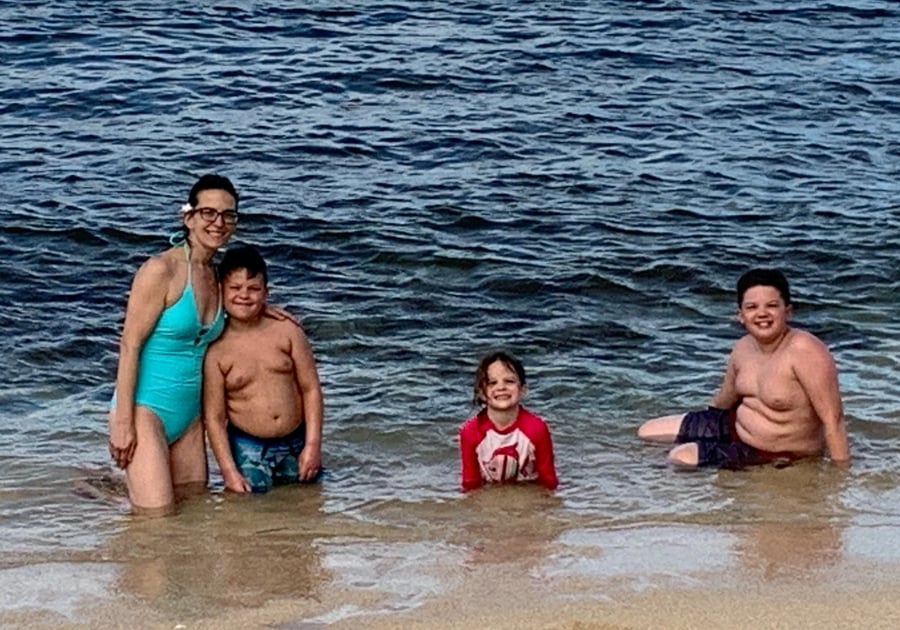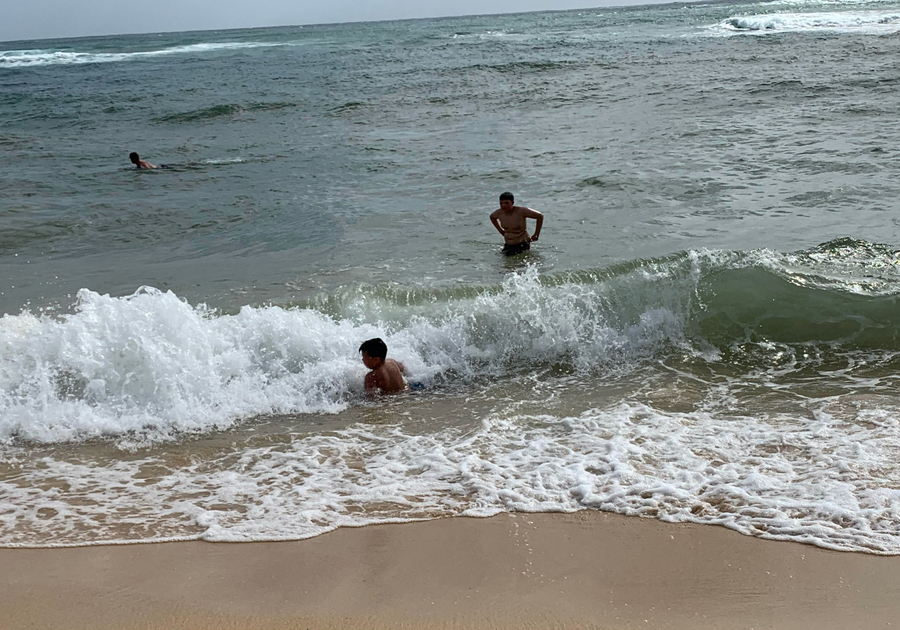I am a pediatric physical therapist who recently started teaching an after school class in Arvada about emotional regulation and mindfulness. Over the winter break, my family and I had the opportunity to vacation on Kauai. The beauty of the lush, green grass, intense colors of the flowers and the calming sounds of the waves really created a relaxing environment to slow down and recharge for a bit. I felt happy to have the chance to create these memories with my husband and children, but for me, the most impactful time was playing in the water. Not only was it fun, but as I reflect back on my time in the ocean, I see many connections to parenting, work, just life in general that are replicated in nature between the power of the ocean and its environment. I would like to share some of my thoughts with you today.
To me, I consider the ocean to be an incredible incubator for sensory and emotional awareness. Since we gain sensory information through our 10 senses and these sensory inputs create emotions that lead to thoughts and finally actions; it is easy to see how spending just a few minutes in the water can provide one with a rich experience to be remembered. Being surrounded with so many inputs, like with the taste of the saltwater, the pressure of the ocean waves supporting you and the smell of the marine life conjured up positive as well as negative emotions. At one point, the ocean threw me into a state of panic and helplessness.
The first step into the ocean was a shock. Transitioning from the warm, smooth sandy beach to the cooler water; with granules of sand squishing between my toes made me feel uneasy. I did not want to go in. I knew, in my head, that I did want to go, but that uncomfortable feeling gave me pause. My husband and kids shouted for me to get in the water, but my initial response was of anger and I yelled back: “No!, I will when I am ready.” But then the wave washed back out for a moment and I stood on the solid sand. I overrode the discomfort and I took another step into the ocean just in time for a wave to smack across my shins. The strength of the incoming waves is incredible. A few more waves crashed into me. One even knocked me back over. And with one more step forward, I stood in the break. This is the worst place to stand, because not only do you get pummeled by the incoming wave, but you are also getting pulled forward by the water flowing back into the ocean. And yet, I felt frozen, paralyzed. Again, I knew that I should be having fun with my family, yet, I could not seem to muster enough strength or coordination to move forward. This was a scary place to stand. Unsure about moving deeper and feeling trapped as if I could not exit the pull of water. For a few moments, I felt helpless. Because I have experienced the ocean before, I knew I had to walk another few steps forward to get on the other side of the break. Once I arrived there, the waves still came, but I was able to move along with them. And all of a sudden I felt relief. I laughed at myself for standing at the edge of the ocean for so long, hesitant to enter, because as I allowed the waves to rise and fall, carrying me along with them, I began to feel happy and lucky to be where I was at. But not more than a few minutes before I had felt so stuck and unsure that I even wanted to do this at all.
Thinking about this experience made me recall a book I read earlier this year, 90 Seconds to a Life You Love, by Joan Rosenberg. She describes in her book that when you feel an emotion, it is chemically processed in your body for about 60-90 seconds. You feel the emotion rise up and then settle back down, just as I experienced with the ocean waves. However, at the start, I was resistant to feeling the waves. I stood just at the edge of the water and allowed the waves to crash harshly into me. I was afraid to go any further for fear of what else would happen. But what did happen? Once I moved out into the waves and fully emerged myself into them, I felt much better. I could see the next wave coming and I knew it was going to be big, but I moved with it. I did not resist it. And then the wave naturally passed. It was not as I had feared. And if I would have allowed that fear to stop me at the edge of the ocean, I would have missed out on the time I spent playing with my three kids and my husband out in the water.
Thinking about how this relates back to my life, or to the lives of my children, it is the perception of fear or danger that causes us to move into a fight, flight, or in my case, freeze response. These reactions are innate within us, but they are not helpful when there really is no threat. In fact, fighting against the experience, actually makes it worse and lowers our ability to deal with challenging moments in our lives.
So what can we do for ourselves and for our children to help them manage difficult emotions, situations, challenges? Joan Rosenberg outlines strategies in her book, but my experience also highlights some key points to consider.
- A calm and alert state is needed for learning and listening - As humans beings, we process sensory information differently. Once we hit the threshold of “too much” we are no longer in a calm and alert state and we act more impulsively or may tune out or act inward with negative thoughts. For me, standing partially in the water with the waves crashing against my legs was my limit. And when my family starting shouting at me, I became angry. I yelled back at them. I was clearly not in a calm state.
- Resistance = Control - When we feel out of control, we try even harder to control the situation. We do this as adults every day. We do it in our jobs, we do it with our kids. So why would we not expect that our children would also do the same with us or even in school. As I stood half-way in the water and half-way out, the waves crashed into me at the same time that the previous wave pulled me back out. I felt helpless, I felt out of control. My attempt to control the situation was to stand my ground and then the next, stronger wave came up on shore and knocked me completely down, under the water. I sucked up saltwater and as the wave pushed me down, sand filled up into my bathing suit. That didn’t work out very well! The same for creating resistance with our children. Someone is going to lose the power struggle. Someone is going to get a mouthful of saltwater, and why fight? Instead, set up the environment for you and your child to be successful. Instead of creating more chaos by yelling at your child when your child yells, try a whisper. Or go back to number one and see what is taking your child out of that calm and alert state? What is causing the perceived threat?
- Moving toward situations with curiosity and awareness can help us move past fear - As I moved forward in the water, the anxiety and fear of being stuck dissolved. As I stopped trying to resist the water and turned my attention toward the goal of getting out into the water with my family, I felt more relaxed and began to enjoy myself. We can do the same with our children in uncomfortable situations. Allow them to “enter the water” on their own terms. Support your child with unconditional love and encouragement. Support and stretch your child toward the next milestone, goal or new situation.
Christine will be offering an online course that pairs video lessons directed both to the child and parent along with weekly parent support calls. Follow this link to subscribe to her newsletter and get a recorded video discussing possible root causes behind quirky behaviors, emotional, sensory and learning challenges.
| |||
Share the Love - Be sure you tell them Macaroni Kid sent you... and tell all your friends!
Macaroni Kid Arvada, Golden and Wheat Ridge is a free local calendar, weekly e-newsletter and website focused on fun family events and information in the area. We gather all kinds of local family events and activities each week, and add useful information about classes, family-focused local businesses, book and product reviews, recipes, crafts, school and camp guides and more.
Quick links to learn more about our community:
 |  | |||
 |  |  |







